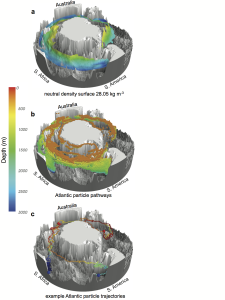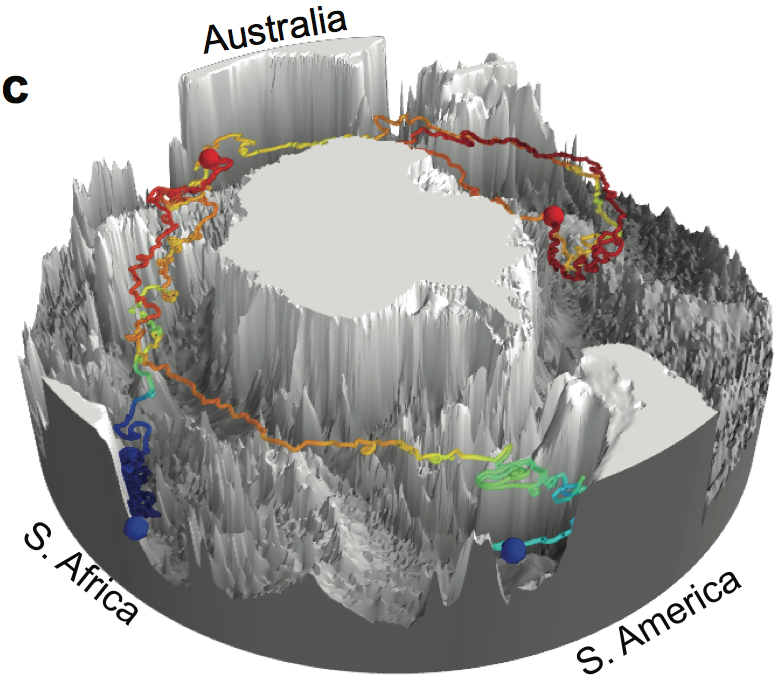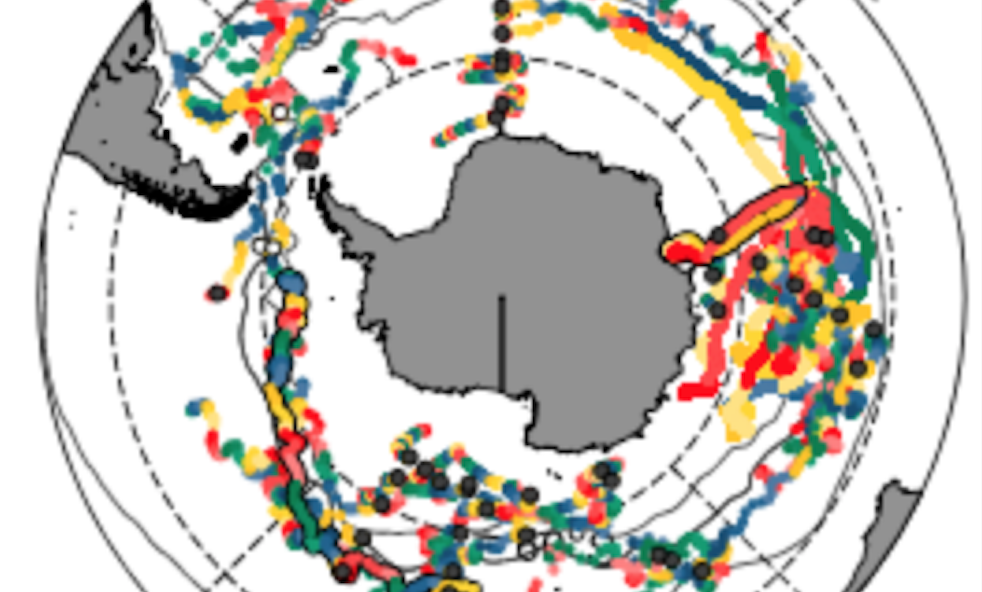Source: Tamsitt, V., Drake, H. F., Morrison, A. K., Talley, L. D., Dufour, C. O., Gray, A. R., … & Weijer, W. (2017). Spiraling pathways of global deep waters to the surface of the Southern Ocean. Nature Communications, 8.
A window to the deep Ocean
Despite covering only 30% of the global ocean area, the Southern Ocean absorbs nearly half of the total carbon dioxide and 75% of the total heat absorbed by the oceans from the atmosphere. By absorbing excess heat and carbon dioxide, the Southern Ocean is damping the effect of global warming. The stability of the future climate depends on the Southern Ocean’s capacity to continue to suck heat out of the atmosphere.
One key reason the Southern Ocean plays such an important role in climate is due to its ability to upwell cold, carbon- and nutrient-rich deep water. Strong winds blowing over the Southern Ocean pull cold, deep water from the ocean abyss to the sea surface, forming a connection between the deep ocean and the atmosphere. Despite the importance of the Southern Ocean upwelling in regulating the climate, the three-dimensional pathways of this upwelling are largely unknown. A new study in Nature Communications combines ocean observations with three state-of-the-art ocean models, revealing the full three-dimensional pathway of deep water to the surface of the Southern Ocean for the first time.
Following the flow
A team of researchers from around the U.S. tracked upwelling by releasing virtual floats in the deep ocean in three ocean models, tracking the path they follow to the surface of the Southern Ocean. With many new measurements in the Southern Ocean in recent decades and with advancements in computing power and data assimilation techniques, scientists have developed high-resolution models which reconstruct the ocean circulation, filling in the details between observations using the physics. These models are powerful because they can be used to test how changes in the system, like rising carbon dioxide in the atmosphere or speeding up winds, will change the way the ocean behaves. The models can also be used to track the path of currents by releasing virtual floats in the model and tracking where the flow carries them.
Using this technique, a group of researchers did the same float release experiment in three state-of-the-art ocean models, revealing the full three-dimensional pathway of deep water to the surface of the Southern Ocean for the first time. Previously it was thought that deep water returned to the surface broadly all the way around Antarctica. This new study shows that deep water is carried to the Southern Ocean in deep, narrow currents, which meet in the Antarctic Circumpolar Current, like highways meeting and forming a high speed freeway that wraps around Antarctica. Most of the deep currents were already well known, but a new pathway was identified carrying deep water from the Indian Ocean to the Southern Ocean along the southern coast of Australia.

Upwelling hot spots
As well as looking at the pathways from the Atlantic, Indian and Pacific to the Southern Ocean, the researchers looked at how the upwelling was related to undersea topography. Scientists have found that large undersea ridges and mountains are very important for mixing water across strong fronts, which usually act as a strong boundary. When the strong current interacts with these ridges and mountains, the current becomes unstable and generates strong eddies, which are efficient at driving water southward across the current, moving heat towards Antarctica. Scientists hypothesized that this topography might also be important for upwelling, however, until now, they haven’t determined exactly how this undersea topography affects upwelling of deep water. The virtual floats in the ocean models showed that the deep water spirals southward toward Antarctica and up to the surface with the help of topographic obstacles: when topography creates hotspots of swirling eddies it push water both southward and upward toward the surface. All three models showed the same result: there are five of these major upwelling hotspots associated with large undersea topographic features, which are responsible for most of the upwelling in the Southern Ocean.

New insights
These results have identified critical regions for upwelling of deep water, which should be targeted with future research expeditions. The researchers have also shown how the role of ocean eddy hotspots can create chimneys connecting the deep ocean with the surface, where the ocean interacts directly with the atmosphere. Three-dimensional modeling of ocean circulation and eddy hotspots is crucial for understanding the ocean’s ability to absorb heat and carbon dioxide from the atmosphere.
I’m a PhD student at Scripps Institution of Oceanography in La Jolla California. My research is focused on the Southern Ocean circulation and it’s role in climate. For my research I sometimes spend months at sea on ice breakers collecting data, and at other times spend months analyzing computer models.



